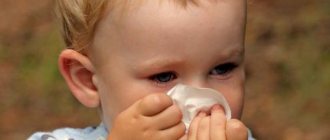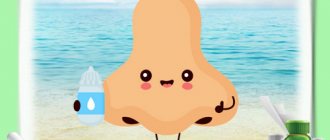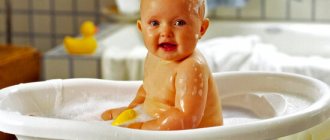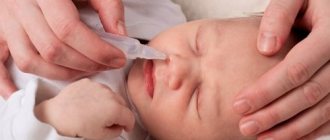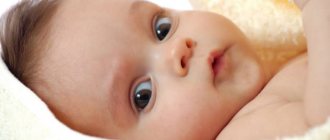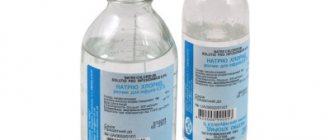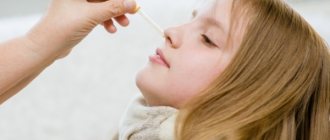Does your child have snot? Treatment is perhaps one of the most common problems that new mothers have to face. If for us, adults, a runny nose is an unpleasant phenomenon, then for children it is a huge problem that can affect the functioning of the entire body with the ensuing consequences.
As a rule, the appearance of this disease is a manifestation of an inflammatory disease of the nasal mucosa - rhinitis, and many novice mothers are immediately perplexed and stupored: how to treat thick snot in a child?
Secret functions
The nasal mucosa secretes muconasal secretion (snot), the main function of which is to protect it from drying out and harmful microorganisms.
The nose is the body’s first barrier of defense against viruses, bacteria, and allergens.
Antiseptic
Nasal secretion acts as an antiseptic, destroys pathogenic microorganisms, and thanks to the ciliated epithelium, which covers the entire nasal mucosa, it removes waste material to the outside. This is how a runny nose appears.
Hydration
In normal condition, the human nose produces a small amount of liquid transparent mucus, which moisturizes and protects the lower respiratory tract from foreign objects (dust, dirt). But once an “enemy agent” enters the body, the volume of muconasal secretion increases significantly, and a fight begins.
A runny nose at the initial stage is always accompanied by clear liquid snot, which gradually becomes thick in consistency, which indicates the child’s recovery. If the disease is caused by a bacterial infection, the muconasal secretion may acquire a yellow or green tint (the color depends on the severity of the disease).
A thick yellow-green runny nose, in which the child has a stuffy nose, should alert parents, as this may be a symptom of sinusitis (sinusitis, frontal sinusitis). The disease should be treated immediately, as the disease quickly becomes chronic and provokes complications.
Why thick
Snot is a mucus based on water, salt and mucin protein. It is mucin that is responsible for the consistency of nasal discharge. So, with a common viral infection, a child develops a profuse runny nose, the consistency of the discharge is liquid, it is transparent and easily flows out of the nasal passages. A few days before recovery, the mucus stops flowing, becomes thick, but remains transparent (sometimes it can be somewhat cloudy).
If the cause of the disease is a bacterial infection, then a larger amount of mucin protein is needed to fight it. The nose, or rather the mucous membrane, begins to actively produce it - now the liquid transparent snot becomes thick in consistency and acquires a characteristic shade (yellow or green).
In addition to a bacterial or viral infection, allergens can provoke a thick runny nose in a child, and the baby may also have a stuffy nose, watery eyes, and sneezing. Usually, with allergies, nasal discharge is clear, but at the same time it can acquire a milky tint, have a foamy consistency and sticky.
Dry air
Quite often, a sticky runny nose is observed in children during the heating season. Insufficiently humidified air leads to drying out of nasal mucus - first it becomes thick, and then dries out completely, forming crusts. Also, a child’s nose is a kind of indicator indicating the amount of moisture in the body. Transparent viscous snot may indicate a lack of fluid, resulting in dysfunction of the body.
Lung diseases
Transparent viscous snot can indicate more serious diseases, such as bronchitis or pneumonia; this manifestation is especially often observed in children of the first year of life. Therefore, parents should not rely on themselves, self-medicating - a qualified doctor should treat the disease.
The baby has thick snot
If a child develops thick snot, how to treat it will be suggested by the recommendations given above. Namely, you need to: regularly ventilate the room in which the baby is located and carry out wet cleaning. In a situation where hyperthermia occurs, you should give your baby boiled water as often as possible. In addition, it is recommended to adhere to the following rules:
- do not force feed the child;
- regularly inspect the nasal passages and suck out mucus;
- take the baby in your arms more often;
- talk kindly to the child.
Every mother is concerned about the treatment of a runny nose with any medications. As Dr. Komarovsky says, a runny nose in a child can be treated with medications, but you should follow the recommendations of pediatricians regarding their prescription.
Thus, vasoconstrictor drugs should be prescribed in a minimal dosage and only in the first two days of the development of the disease. To do this, you can use products such as “DlyaNos” (0.05%) and children’s “Otrivin”, which are indicated for infants.
If it is necessary to use antiviral and antibacterial drugs, the following can be used:
- drops "Protargol";
- nasal drops "Grippferon";
- oil-based drops “Retinol”, “Ectericide”, “Tocopherol”;
- rectal suppositories "Viferon";
- children's spray "Isofra".
When using these drugs, you should carefully read the instructions for use, and it is better to consult your pediatrician.
How to get rid
Since thick snot significantly complicates a child’s nasal breathing, it needs to be gotten rid of and this should be done correctly.
Liquefaction
Initially, a sticky runny nose should be thinned - drop a few drops of Aquamaris, Aqualor, Humer, No-Sol saline solution into the baby’s nose. Ordinary saline solution or a weak decoction of medicinal herbs (chamomile, St. John's wort, etc.) are also suitable. Older children are advised to rinse their nose and then get rid of mucus by blowing their nose.
For young children, they do this - after instillation, wait 5 to 10 minutes, then, using an aspirator or gauze flagella, remove the softened secretion from the nose. Some parents use an ordinary syringe (without a needle) as an aspirator, but then they need to secure the child’s head tightly so as not to injure the delicate nasal mucosa.
These manipulations help free the baby’s nose from viscous mucus, but do not eliminate the cause of the runny nose. The disease must be treated. Based on the nature of the disease, the doctor prescribes an antiviral, antibacterial or antihistamine, mainly for topical use. Vasoconstrictor drops can also be prescribed; they can be used to normalize nasal breathing. You cannot prescribe medications on your own.
Prevention
To avoid thickening of nasal mucus, parents should remember:
- the optimal air humidity in the room is 50-60% - place a container of water on the heating radiator (at least 1.5 liters should evaporate daily);
- Regular wet cleaning will help prevent an allergic reaction - quite often house dust, wool, fluff, and feathers are allergy triggers;
- drink plenty of water - water, this is life, give your child more fluids especially during illness; water procedures - if the baby does not have a fever, be sure to bathe him; steam improves nasal breathing and prevents mucus from thickening.
One more thing - do not use traditional medicine; breast milk, beet and carrot juice will not rid the baby of viscous snot, but, on the contrary, will provide a favorable environment for the proliferation of pathogenic microorganisms. A qualified doctor must treat children.
If a child develops liquid, transparent snot, this is a clear sign of an acute respiratory infection or an incipient allergy. Is it necessary to treat such snot? Nasal mucus in a child is produced in the same way as in an adult and does not pose any threat. The appearance of clear snot indicates that the body is beginning to protect itself from the effects of the virus.
Mucus secretion occurs when the body fights viruses and allergens , preventing them from spreading. When does a baby’s clear discharge need to be treated, and in what cases can his condition be alleviated with the help of nasal hygiene? Let's try to figure this out.
Recommendations for preventing snot
Children, more often than adults, experience nasal congestion for various reasons. Proper prevention and following the rules of a healthy lifestyle help strengthen the child’s body:
- daily walks outside and airing the room;
- steaming feet when hypothermic outdoors;
- taking vitamins or eating seasonal fruits;
- visiting the dentist every six months;
- in case of allergies, special medications must be present in the house;
- during periods of high incidence, you should avoid crowded places;
- in the cold season, when visiting places with a high concentration of children, it is necessary to use Oxolinic ointment.
The basics of a healthy lifestyle, which are instilled by parents from childhood, will strengthen the immune system and make the body healthy.
Source
Causes of clear snot
Adaptation to new living conditions
A baby may develop a runny nose immediately after birth. In this way, the body reacts to the emergence of new living conditions and adapts to them. Transparent snot can appear due to a long stay in the womb or indicate disturbances during labor.
A runny nose can occur when exposed to certain factors that create unpleasant conditions for the child’s nasopharynx. The nasal mucosa dries out due to too low air humidity, reacting to this with clear liquid secretions that resemble water. Since the baby does not yet know how to blow his nose, clear snot begins to accumulate in his nose, making it difficult for him to breathe. Parents should constantly remove the resulting clear discharge.
Teething
What does clear snot mean in a child? They can be triggered by teething . This is explained by the fact that the processes of blood supply to the gums and nasopharynx are closely related. When blood rushes to the gums, in this case it also flows to the nasopharynx area. When blood flow increases, the production of mucus in the nose accelerates, contributing to the appearance of a runny nose. It is impossible to fight this phenomenon, so you need to wait out such symptoms, eliminating the clear liquid and avoiding nasal congestion.
Allergic reactions
Quite often, clear mucus occurs due to allergic reactions. This is especially true in the spring during the active flowering of plants. Allergies manifest themselves as follows:
- clear nasal discharge;
- redness of the eyes;
- rash and redness on the body;
- skin itching;
- swelling of the mucous membranes of the eyes.
With an allergic rhinitis, a child sneezes very often. Parents should find out what is the source of the allergy. Usually, after contact with an allergen, a reaction occurs in the form of a runny nose and other symptoms. Treatment of such a runny nose involves protecting the child from contact with the allergen. In especially severe cases (swelling, shortness of breath, other external signs), the child should be given antihistamines .
Viral diseases
Another common cause of clear snot in a child is viral diseases. At the beginning of the development of the disease, liquid transparent snot begins to flow from the baby’s nose, which then noticeably thickens. If such discharge is white and not transparent, then this indicates the development of inflammation and the spread of infection in the body. Viral diseases must be treated comprehensively.
Basic measures in the treatment of green snot
Once the diagnosis has been made by the attending pediatrician, both medications and folk remedies can be prescribed. In especially severe cases, when thick yellow snot appears in a child, antibacterial medications may be recommended for a bacterial infection and antiviral medications for a viral one.
Treatment of the disease should begin with the maximum release of mucus from the sinuses and passages to ensure comfortable free breathing for the baby.
You can clear the nasal passages when thick yellow snot appears in a child using a regular syringe bulb. By the way, this procedure is recommended before each nasal rinsing or instillation of medications.
You can rinse your nose with special solutions that are sold in pharmacies, or with self-prepared salt water. In the latter case, the solution should not be stronger than one teaspoon of salt per liter of boiled water. You can use either sea salt or regular table salt. For infants, it is recommended to take special rinsing solutions, which can be purchased at the pharmacy. They contain microelement composition in the most optimal proportion.
Transparent snot in a child: how to treat it?
Before treating clear snot in a child, you need to show him to a doctor, who will find out the exact cause of its occurrence. Regardless of the etiology of the runny nose, its treatment necessarily includes the procedure of cleansing and rinsing the nasal canals.
Washing baby's nose
If a child has snot that resembles water, then a nasal aspirator . If the mucus is too thick and viscous, then it must first be liquefied with saline or a decoction of medicinal herbs, using St. John's wort, chamomile or sage for its preparation. For these purposes, you can also purchase a pharmaceutical saline solution:
- Humer;
- Dolphin;
- Aqualor;
- Salin;
- Aquamaris.
A few drops of decoction or freshly prepared solution are instilled into each nasal canal, after which the diluted secretion is sucked out using an aspirator.
Any procedures that are carried out using nasal drops or sprays are carried out only after thorough cleansing of the nasal passages. When a small child learns to blow his nose on his own, he will need to be constantly reminded to do it himself.
Treatment of a runny nose with acute respiratory infections or acute respiratory viral infections
Liquid transparent snot in a child who has fallen ill with a viral infection or acute respiratory infection, after some time is replaced by thick discharge. Treatment of such a runny nose should be carried out only with strict adherence to bed rest.
A runny nose of any etiology, which is accompanied by the release of a transparent mucous secretion, should be treated with vasoconstrictors (Nazivin, Nazol, Rinonorm, Vibrocil, Naphthyzin, Galazolin, Sanorin). Such medications alleviate the patient’s condition and reduce the amount of mucous secretion only for a while. They cannot cure a runny nose. It is recommended to use them no more than seven days .
Treatment of liquid mucous discharge during the first three days after the onset of the disease is carried out using human interferon preparations. These include Grippferon and Interferon. Clear snot in the form of water can be treated by inhalation using a nebulizer charged with an interferon solution.
Infectious rhinitis is usually treated with immunomodulatory drugs. Sinupret is considered the most effective - a drug that consists of natural ingredients.
With ARVI, natural recovery usually occurs faster if the child is provided with access to cool and fresh air, as well as a normal drinking regime. becomes thick after a very short time , making it difficult to breathe through the nose and increasing the risk of spreading the virus, as well as the addition of a secondary bacterial infection.
Treatment of allergic rhinitis
If a child’s liquid transparent snot occurs as a result of an allergic reaction, then it is necessary to find out which allergen contributed to its development.
Treatment of allergic rhinitis is carried out with antihistamines in compliance with strict dosages. Before doing this, you should definitely consult an allergist, who will select the right drug. An advanced disease can cause the development of bronchial asthma .
Thus, clear snot in a child may indicate either the presence of an infection in the body or be a reaction to a certain allergen. The baby needs to be shown to a doctor who will conduct an examination, make the correct diagnosis and prescribe appropriate treatment.
Transparent snot in a child is a rapid reaction of the child’s body to irritants of the nasal mucosa. Under normal conditions, a small amount of fluid in the nasal cavity is responsible for humidifying the air and clearing it of dust particles and other substances. Excess mucus indicates a developing inflammatory process. The treatment regimen for the baby in such a case depends on the causes of the symptom.
Why does my child have clear snot?
There is a group of factors that can lead to the appearance of abundant clear mucus from the nasal passages in a child:
- ARVI. This is the most common viral infection. The initial clinical picture is manifested by dry mucous membranes, sore throat, then the patient sneezes and his nose is stuffy. On the second day, the child develops liquid, transparent snot - this means that the body has begun to actively fight the infection.
- Allergic reaction. If the clinical symptoms do not indicate the course of a viral disease, and the characteristic discharge bothers the small patient, we are talking about the possibility of an allergic cause of the phenomenon.
- Time of active tooth growth. Transparent snot in a baby often indicates just such changes. This process starts from six months and ends by 2–3 years. In addition to nasal mucus, the baby develops increased salivation. The symptoms that appear are caused by the active flow of blood to the gums and nasopharynx at the time of teething.
- Dry air. When the room is hot, low humidity has a detrimental effect on the nasal mucosa, threatening the latter with drying out. As a result, the body’s self-defense is activated, which is expressed in the production of a large amount of secretion.
- Adaptation period. A baby may develop snot immediately after birth. In this case, we are talking about a physiological runny nose, which is caused by the reaction of the child’s body to new living conditions and the structural features of the newborn’s nasopharynx.
Attention! A less common cause of clear snot is the presence of a foreign body in the child's nasal passage. The same applies to whooping cough, mononucleosis, rubella, chickenpox and measles - infectious diseases accompanied by the manifestation of a characteristic symptom.
How to treat clear snot in a child?
If a child has runny, clear snot, the patient should be shown to a pediatrician. The specialist, after conducting a survey and examination, prescribes one of the treatment regimens. In some cases, to determine it, you may need to consult an otolaryngologist or allergist.
Features of therapy for viral disease
The principle of treating an infection, be it ARVI or another ailment, is the same: it is necessary to adhere to the complexity of therapy. At the initial stage of the appearance of liquid snot in a child, like water, you should:
- Relieve the patient's condition by using antipyretics (Ibuprofen, Paracetamol). Taking medications is justified if the child has a temperature above 38 degrees. Antipyretics lead to dry nose - after a while, the snot may thicken a little.
- Get rid of physiological cough caused by liquid secretions. For these purposes, mucolytics (Bromhexine, Ambroxol) are used. The use of expectorants is contraindicated in children under 2 years of age.
- Eliminate the provocateur of the disease using antiviral drugs (Nazoferon, Grippferon).
- Get rid of snot by rinsing your nose. For these purposes, a nasal aspirator is used. For thick mucus, preliminary thinning of it with saline or pharmaceutical saline solutions (Salin, Aqualor, Aquamaris) is indicated.
- Provide comprehensive treatment by resorting to the use of nasal drops (Delufen, Rinitol). Medicines will relieve congestion and moisturize the mucous membrane.
Treatment of allergic rhinitis
Nasal discharge caused by the virus should clear up within 7 days. If a child’s clear snot does not go away for more than a week, it can be said that the patient is experiencing an allergic rhinitis. The disease is seasonal and often develops against the background of flowering plants. The clinical picture is complemented by the following symptoms:
- skin rash, redness;
- itching in the nose, ears, eyes;
- frequent sneezing;
- congestion.
Medical recommendations for a runny nose of an allergic nature are given in the table below:
White snot in babies, especially thick ones, is the first signal of the onset of the disease and the final stage in the development of allergies. Liquid discharge from the baby's nose may indicate overheating, a cold, advanced caries or teething. If there is more and more snot, it becomes thicker, and a greenish or yellow color appears, which means that there is a source of infection in the child’s body and it is necessary to show it to the doctor.
Basic recommendations for the treatment of white snot
It is recommended to treat thick white snot in a child after determining the cause of its appearance. Initially, as in the treatment of any type of snot, it is recommended to rinse the nose to clear it of mucus and microorganisms. It is possible to use vasoconstrictor drops, which should not be used more often than 3-4 times a day. To combat inflammation, you can use Protargol and Collargol drops along with antiallergic or antibacterial drugs. Thick white snot in a child responds quite well to treatment with the anti-inflammatory ointment Viprosal.
Reasons for appearance
White snot in a child is always unpleasant for both the baby and his parents. But the discharge of mucus from the nose is just a symptom indicating a specific disease or an allergen entering the body.
The reasons for the appearance of light snot from the nose can be:
- Weakened immunity. During the autumn-winter period, the baby’s body is not able to cope with the attack of microbes. Due to the special structure of the nasal passages (in children they are narrow), any virus that gets onto the mucous membrane can lead to inflammation with copious mucus secretion.
- Hypothermia. In damp, cold weather, a child may catch a cold. The first symptom of an incipient disease may be snot.
- Overheating also causes nasal discharge. The child sweats, moisture loss occurs, and the protective function of the nasal mucosa decreases.
Possible diseases characterized by the discharge of white mucus from the nose:
- adenoiditis;
- sinusitis;
- sinusitis;
- complications from measles or flu;
- ethmoiditis;
- nasal polyps.
The appearance of snot can be preceded by the entry of an allergen into the body, as well as seasonal phenomena - dry air in the room, flowering of plants and trees. An allergic reaction - discharge of mucus from the nose - may be accompanied by lacrimation, cough, skin manifestations: dermatitis, urticaria.
In children under 6 months of age, white snot may indicate the following phenomena:
- In newborns, white mucus may appear due to complications during childbirth or poor adaptation.
- During the period of teething, snot is observed in 60% of children.
- Once the baby reaches 6 months, breast milk is gradually replaced by complementary foods, which can lead to a decrease in the number of antibodies in the baby’s body. He becomes more vulnerable to viruses, and clear white snot may indicate the onset of the disease.
Etiology of rhinitis in children
In babies, the appearance of thick snot has good reasons, such as a viral or bacterial infection or allergic diseases.
If a child develops thick snot, Komarovsky advises solving this problem immediately. He points out that infants are most susceptible to the occurrence of this disease, which is associated with the low secretory ability of the nasal mucosa, difficult and narrow nasal passages, as well as the absence of the cartilaginous part of the nasal septum.
These circumstances make it difficult to warm and purify the inhaled air and create quite favorable conditions for microbial and viral contamination. In other words, the occurrence of a runny nose in children is due to poorly formed immune defense, and its complex manifestation is reduced to diseases such as rhinitis and pharyngitis.
If a child has snot, what should you do? Knowing certain features of the functioning of the baby’s body and its growth, mothers are no longer surprised by the appearance of snot after a walk.
The main reasons that can cause a runny nose are:
- infectious;
- vasomotor;
- hypertrophic;
- allergic.
According to Dr. Komarovsky, it is also worth adding a medicinal reason to this list.
The occurrence of vasomotor rhinitis can be caused by a number of factors, such as hot food, psycho-emotional experiences, smoke, etc. This reason is indicated by clear, thick snot in a child.
The occurrence of infectious rhinitis is usually associated with the presence of a microbial, viral or fungal pathogen, and it can appear against the background of various diseases: influenza, colds, scarlet fever, etc.
The allergic component that causes thick snot in the child requires special attention. What to treat can be suggested by medical statistics, which indicate a progressive annual increase in the number of children suffering from various allergic diseases. It is quite clear that the cause of such a runny nose is contact with an allergen, and its distinctive feature is the presence of white snot.
Long-term use of vasoconstrictor medications determines the appearance of drug-induced rhinitis, or, in other words, drug dependence.
The appearance of various types of injuries to the nasal mucosa predetermines the presence of traumatic rhinitis. Causes may include mechanical, chemical or thermal injuries.
When an overgrowth of the nasal mucosa appears, a hypertrophic runny nose is formed, and when it atrophies, an atrophic one is formed.
Varieties and nature of occurrence
White snot occurs for a specific reason:
- Infectious runny nose is caused by viruses, fungi or bacteria. In addition to mucus secretion, there is an increase in body temperature and inflammation.
- Vasomotor type. The cause is strong anxiety, dry air, inhalation of toxic substances (paints, tobacco smoke).
- Allergic nature of runny nose. A characteristic sign is white thick snot without fever or inflammation.
- Traumatic runny nose with white secretion. It is caused by thinning of the mucous membrane and tissue proliferation in the nose.
- Medication type. Due to long-term use of vasoconstrictor drugs, dependence on them occurs. This leads to a chronic runny nose with the release of light, liquid snot.
What complications can there be?
In itself, a runny nose in a child is a completely harmless symptom that does not require special treatment. But if left untreated, it can lead to unpleasant consequences:
- spread of inflammation to the throat, ears;
- inflammation of the deep sinuses, sinusitis (can occur as early as three years of age);
- addition of a bacterial infection.
The child's quality of life deteriorates. White mucus, if it is very thick, interferes with sleep and eating. When breathing through the mouth, the mucous membrane dries out. Thin, white mucus can irritate the skin under the nose.
Which doctor should I contact?
White snot without fever and other symptoms of a viral disease can be successfully treated at home with regular rinsing. However, if nasal discharge becomes greenish or yellow in color, you should definitely visit an otolaryngologist or pediatrician with your child. This is also important to do if the nasal discharge does not go away for 7-10 days or even gets worse.
The doctor conducts a visual examination and collects complaints about the child’s condition. In some cases, when the snot is very thick, an x-ray may be prescribed to rule out sinusitis and other diseases.
You may also need to consult a dentist if the cause of the white secretion is advanced caries. And if an X-ray reveals a curvature of the nasal septum or a foreign object, you should contact a surgeon for advice.
A child under one year old must be shown to a doctor immediately when white snot appears. It is necessary to find and eliminate the cause of the runny nose, and not the symptom itself.
Treatment of a runny nose
How to treat white snot in a child? The tactics for getting rid of white discharge vary depending on the provoking factors. If a runny nose develops due to a viral infection in the body, it will go away without treatment in about a week. In this case, it is enough just to clear your nose and drink the required amount of water. Immunity to the pathogen will develop in 7-10 days. Here the main task of parents is to prevent secondary infection.
When the upper teeth erupt, irritation of the walls of the nasopharynx occurs, which causes the release of fluid. This process does not require treatment. In order to maintain normal breathing, it is necessary to clear the nasal passages.
It is necessary to treat not the symptoms in the form of a runny nose, but the cause of the disease. If the symptom arose due to teething or a transition to a different type of diet, intervention is not necessary. But in other conditions you need to know what to do:
- allergy. If a child has hypersensitivity to foreign proteins, then it is necessary to eliminate the allergen itself. Usually a runny nose is only symptomatic. When you take special medications, it goes away quickly;
- first stage of a cold. A runny nose in a child indicates the onset of a respiratory infection. Then it is necessary to take drugs with antiviral activity;
- weakened immune defense. Children with weak immune systems often suffer from various diseases accompanied by the formation of mucus from the nasal passages. In this case, it is necessary to resort to means that improve immunity - taking vitamins, preventing hypothermia, and proper nutrition.
Medicines for the common cold
Every parent strives to help their child by easing his suffering from illness. Therefore, the question of choosing a drug comes first.
Of all the remedies presented for eliminating this symptom, the fastest-acting are drugs with vasoconstrictor activity. But their use is not so safe. With prolonged use, side effects in the form of addiction may develop.
After taking such drugs, swelling of the mucous membrane develops. This symptom persists for some time, even after getting rid of the snot. To get rid of swelling, further medication will be required.
Treatment of the disease
Parents can help their child before visiting the doctor:
- rinsing the nose with salt water, saline, and preparations based on sea water;
- vasoconstrictor drugs no more than 2-3 times a day, preferably only at night;
- humidifying the air in the room;
- plenty of warm drinks.
After identifying the cause of white snot, appropriate treatment is prescribed:
- antiviral drugs;
- antibiotics;
- antihistamines and so on.
The discharge of white snot from a child's nose can have a serious reason or be a consequence of exposure to temperature, prolonged crying, or stress. It is difficult to identify the root cause on your own, so children under 1–2 years of age, especially those with a persistent runny nose, should be shown to a specialist. It is also worth calling a doctor at home when other symptoms are present: high body temperature, cough, rash, lacrimation, lethargy, vomiting, upset stool.
Although there is an opinion that snot goes away on its own within 7 days, treatment should not be delayed. The speed of the baby’s recovery depends on the adequate help of parents:
- rinse your nose at least 5-6 times a day or more often;
- vasoconstrictor drugs - only as prescribed by a doctor;
- humidify the air in the room so that the nasal mucosa does not dry out;
- carry out vitamin therapy in the autumn-winter period;
- when teething in infants, use special pain-relieving gels and rubber “gnawers”;
- Visit the dentist with your children at least once every six months for timely treatment of caries.
It is advisable to use an aspirator if the child is small and cannot blow his nose on his own. Before blowing your nose, the nasal passages must be rinsed.
An adult gets a runny nose several times a year, let alone children. Young children are susceptible to frequent rhinitis, and it is good if the disease is limited to “week-long” snot and does not develop into something more serious.
As a rule, snot is either allergic or viral in origin; it may not be accompanied by any other symptoms for a long time and may not worsen the baby’s overall well-being. However, this does not mean that it does not make sense to visit a pediatrician and rule out an inflammatory process in the respiratory system. If treatment is not started in time, it can lead to complications such as sinusitis, pneumonia, otitis media, meningitis, etc.
Traditional methods
Some folk methods that our mothers and grandmothers used will help alleviate the baby’s condition.
So, to rinse the nose, you can use not only salt water, but also a freshly prepared and cooled decoction or infusion of chamomile at the rate of two teaspoons per glass of water.
To carry out “disinfection” in the room, you can put an onion cut in half or into 4 parts. Inhaling the phytoncides secreted by it will help break through a stuffy nose. After some time, the swelling of the mucous membrane will decrease, and the baby’s breathing will become easier.
You can also lubricate the nasal passages with sea buckthorn oil, which will have a preventive effect in the formation of crusts.
You can lubricate your baby’s feet with “Star” balm three to five times a day, combining this procedure with massage.
You can instill aloe or Kalanchoe juice. Freshly prepared carrot or beet juice, diluted with boiled water in equal proportions, is also good for a runny nose.
Symptoms and complications
Thick snot in a child is considered a sign of the last stage of a cold, when the production of pathological mucus decreases and the remains of the infection are eliminated. This is in a good state of affairs. But more often they indicate a viral or bacterial disease that has “settled” in the nasal cavity. The mucous membranes try to contain the infection and prevent it from entering the lower parts of the respiratory system.
Prolonged, incorrect or completely absent treatment of a runny nose causes a significant deterioration of the condition.
It is possible that thick mucus will become more complex:
- temperature;
- the ability to breathe only through the mouth;
- hearing impairment;
- partial or complete loss of smell;
- lack of appetite;
- inability to fully pull breast or formula from a bottle;
- irritability and tearfulness;
- abnormal night sleep, etc.
In an infant, thick snot invariably leads to oxygen starvation of the brain and delayed development in general. In medical practice, cases of infants suffocating due to mucus tightly blocking the nasal passages have been recorded.
Provoking factors
Thick snot can be of the following nature:
- infectious;
- hypertrophic;
- vasomotor;
- allergic.
An infectious runny nose is a sign of the presence of a virus, fungus or microbes in the body. All these pathological irritants develop against the background of an underlying disease - scarlet fever, influenza or a cold.
Vasomotor runny nose, which is accompanied by thick snot, is the result of a stressful situation, inhalation of smoke, the presence of foreign bodies in the nasal passages, or prolonged exposure to a smoky room. In most cases, the thick, glue-like discharge disappears when the irritating circumstance is eliminated.
But it also happens that vasomotor rhinitis requires complex treatment of the child. As a rule, serious therapeutic measures are aimed at removing polyps and adenoids, disruptions in the gastrointestinal tract, removing a foreign body from the nasal passages, or eliminating the consequences of severe hypothermia. Hypertrophic rhinitis can be treated exclusively with surgical methods. The fact is that viscous snot in a child with this diagnosis is the result of loosening or complete death of the mucous membrane in the nasopharynx or the absence of flickering cilia on it.
An allergic runny nose is accompanied by clear snot, the intensity of production of which depends on the proximity of the irritant and the frequency of contact with it, the presence of at least some treatment and actions on the part of the child’s parents.
Therapeutic measures
The desire to treat a small child exclusively with folk methods can be praised, but it can hardly be called correct. All non-traditional methods are only auxiliary, that is, they enhance the main drug treatment.
Among adherents of eco-medicine, the following methods of treating rhinitis are held in special esteem:
- Instillation of fresh beet, carrot or parsley juice into the nasal passages, diluted with boiled water in a 1:1 ratio. For an infant, one drop in each nostril three times a day is enough. A child 2-3 years old requires an increased dose of 2-3 drops three times a day;
- Rinsing the nasopharynx, allowing you to remove accumulated thick snot from it. For this purpose, a self-prepared saline solution with the addition of a few drops of iodine is used. Place a tsp on a glass of boiled water. table or sea salt, no more, otherwise there is a risk of burning the mucous membrane;
- Instilling homemade drops into the nose. Half a tsp. marigold and yarrow should be poured with a glass of boiling water, everything should be placed in a steam bath and heated for 15 minutes. Then the solution is cooled, filtered and placed in the child’s nose a couple of drops three times a day;
- Thick mucus in children 3-4 years old can be treated with garlic drops. To prepare them, you need to pass a small head of garlic through a press, pour the mixture with olive or vegetable oil, leave the product for 10 minutes and, after straining, instill a couple of drops into each nasal passage. Initially, the child may experience a burning sensation, which quickly passes. Thick snot will disappear at approximately the same speed (at least, that’s what adherents of herbal medicine say).
To treat thick or clear snot in a child, relying only on official medicine, means following the following sequence of actions:
- Liquefaction of mucous secretions;
- Washing away dried crusts and secretions;
- Instillation of vasoconstrictor, antiallergic or antibacterial medications (depending on the nature of the child’s runny nose).
Vasoconstrictor drugs
To facilitate nasal breathing, vasoconstrictors are prescribed. They relieve swelling of the mucous membrane, reduce the amount of mucus secreted and enhance the healing effect of other drugs.
It is important to buy age-appropriate medications and not use them for more than 10 days. Among vasoconstrictor pharmaceutical products, the most popular are “Vibrocil”, “Brizolin” and the budget “Farmazolin”.
Antibiotics
If a child's thick or clear snot is caused by bacteria, it is time for topical antibiotics.
These include the well-known “Bioparox”, “Isofra” or “Protargol”. Their worthy analogues are Bactroban ointment and the local immunomodulator Derinat.
Clear snot that does not go away within a month and does not respond to measures taken by parents may indicate a deep-seated infection. In this case, you need to undergo a set of laboratory tests to determine its type and take a course of antibiotics aimed at destroying a specific virus, bacteria, fungus. As a rule, such tactics make the snot go away quickly and for a long time.
Homeopathy
Homeopathic medicines Ocarizalia and Euphorbium Compositum provide a good healing effect. Again, you should not hope that these products will remove clear snot in a few days. All of them have a cumulative positive effect, speed up recovery and extend the period of life without a runny nose.
Prevention of colds and viral diseases plays a big role in the development of immunity in young children. And the task of parents is to provide them with all the conditions for healthy and full development, especially since this is not difficult or expensive.
Good nutrition, outdoor exercise, physical activity and emotional balance are the ingredients for children to live a drug-free life.
The development of a runny nose and its stages
Of course, the process of the appearance of rhinitis has certain stages in development.
- The appearance of swelling and swelling of the mucous membrane, which can last for several days.
- Increased secretory activity of the epithelium.
- Generalization of inflammation.
When primary symptoms appear, that is, when the development of rhinitis enters the first stage, it becomes difficult for the baby to breathe through the nasal passages. The peculiarity is that we, adults, easily begin to breathe through our mouths, but it is difficult for a child to do this. This determines the appearance of shortness of breath and refusal of the breast or bottle of formula. After all, the baby simply doesn’t know how to eat and breathe at the same time through a nose clogged with snot.
